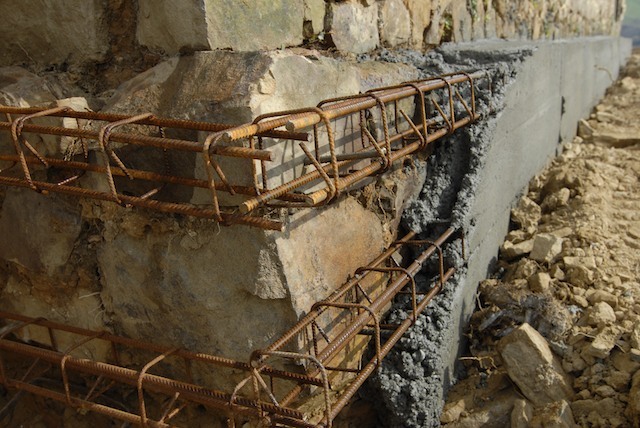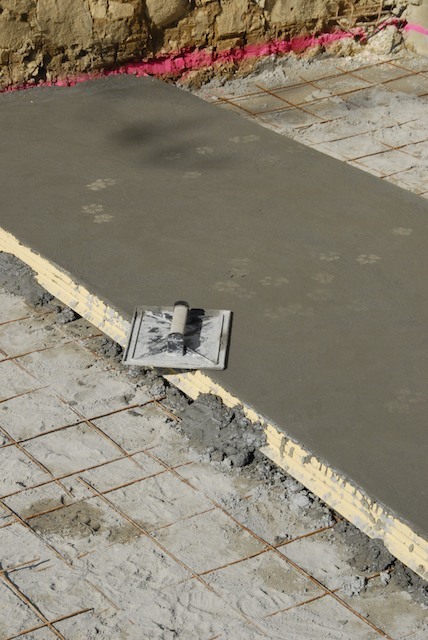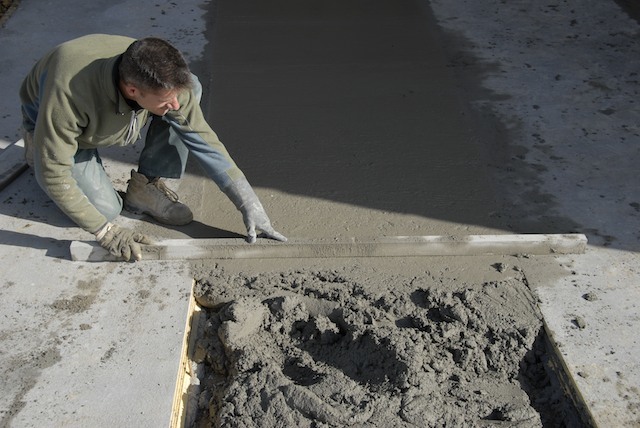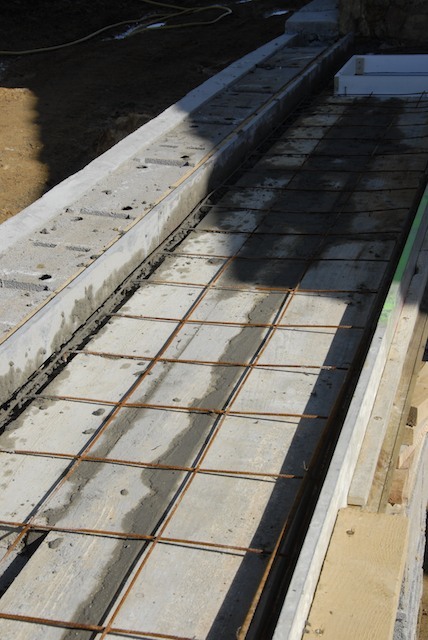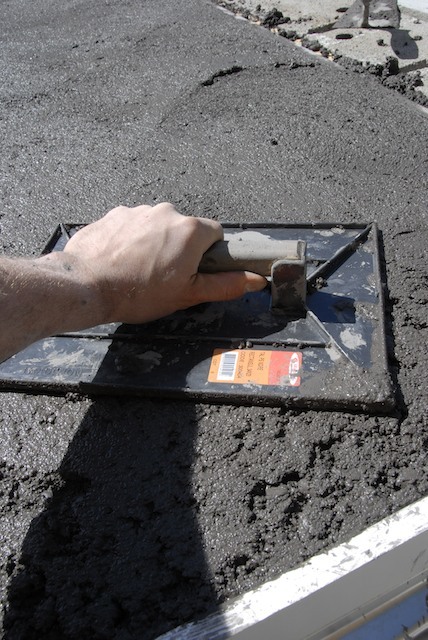You should start by excavating the threshold to a depth of 40 cm beneath the final floor level. Do it gently, those dressed stones at the base could be loose. You can extend your excavation outside of the building a little too if you like, 10cm should be enough. Make your trench a little wider than the width of the wall about 4cm. At this point you could just fill the hole with concrete but it wouldn’t be a very elegant approach, to get nice straight sides to your threshold you’ll need to shutter it. Cut some timber/s the width of the opening by the depth of the trench and place them in the hole on either side, they will form the mould for the concrete, (cheap shuttering timber is called bois de coffrage in French and should cost about 3€ a piece 2m x 20cm, at a timber yard - DIY store could easily be double that) keep them in place by driving some 10mm reinforcing bar into the ground on either side of the timbers, cut them or hammer them into the ground just below the tops of the boards. You can carefully backfill the outer sides of the mould now, this will help stop the concrete forcing the boards outwards when you pour it.
The tops of the boards will be the final level, so adjust them accordingly, make the front one a tiny bit lower to allow rainwater to drain away from the building, you can use stones to wedge up the underside of the boards if you need to, just make sure it’s all sturdy otherwise it will collapse under the weight of the concrete, and you won’t be able to do much about it.
So now you have your nice clean excavation with shuttering boards placed in the trench on either side and it’s all secure. You need to cut some more re-bar to go in there, what you need is called longrine in French (in some builders yards anyway) and its basically re-bar in a box section, (see photos). place it in the hole, put enough in the fill the space entirely, perhaps 2 pieces, one on top of the other 30 x 20cm or more smaller ones, not really important as long as you have some steel in there. This is what differentiates concrete from re-inforced concrete.
At this point I would drill some 10mm holes in the timber on the inside of the barn about 5cm from the top of the boards, pass some 10mm bar through the holes leaving at least 10cm on either side, these bars will connect your concrete slab to the threshold when you come to do that later. If you don’t do this the slab will probably separate from the threshold at some point.
Determine the quantity of materials required. For example, if the interior dimensions of your shuttering are 2m x 40cm x 40cm, the volume of materials required will be 2 x .4 x .4 or 0.32 cubic meters. A 35kg bag of cement will make about 190kg of concrete, you will need 3 or 4 bags of cement to make enough concrete to fill your hole, check the bag for the exact mix (consistency is important, too wet and it will be weak, too dry and it won’t mix properly). It will be something like 1 part cement 2 parts sand 3 parts gravel, you can buy the sand and gravel already mixed making the job a bit simpler.
You could mix this amount by hand in a barrow or on a board on the floor but if you can get your hands on a mixer, it will be much easier. Mix up the concrete and pour it from the wheelbarrow or shovel it in to the hole, poke it down in between the bars with a broom handle so you don’t end up with cavities. When it’s full, which will be a good few mixes in a little electric mixer, you can begin to work on the surface finish.
Using a screed batten that you already cut to length, just a piece of timber about 40cm wide and long enough to over lap the width of the shuttering, tamp down the concrete working from one side of the opening to the other, the batten will be guided by the tops of the shuttering that you levelled up nicely earlier, draw any excess concrete off using a sawing side to side motion. Don’t mess with it too much or you will bring excess water to the surface weakening it. After a little while, maybe 20 minutes, depending on the weather, you can finish of the surface if you wish by smoothing it over with a trowel. I just noticed re-reading your post that you wanted a bevelled edge, you could do this now by cutting some of the concrete away with your trowel, but if you want it to look really good, then you should have attached a triangular shaped piece of timber to the top of the shuttering board.
Leave it to harden - you’ll be able to carefully remove the shuttering timber the following day, but if you can be patient and leave it for a couple of days you’ll be less likely to damage the edges.
That’s it! Hope that makes sense? Ask away if not.
James
